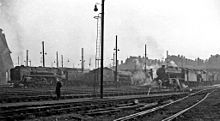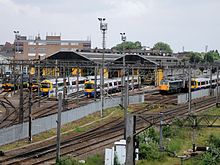
The Bakerloo line is a London Underground line that runs from Harrow & Wealdstone in suburban north-west London to Elephant & Castle in south London, via the West End. Printed in brown on the Tube map, it serves 25 stations, 15 of which are underground, over 23.2 kilometres (14.4 mi). It runs partly on the surface and partly through deep-level tube tunnels.

The North London line is a railway line which passes through the inner suburbs of London, England between Richmond in the south-west and Stratford in the east, avoiding central London. Its route is a rough semicircle.

Queen's Park is an interchange station situated on the Bakerloo line of the London Underground and the Lioness line of the London Overground. It lies at the southern end of Salusbury Road, near the south-east corner of the public park from which the area now known as Queen's Park has taken its modern name. The station is in Travelcard Zone 2.

Kensal Green is an interchange station served by Bakerloo line services of the London Underground and Lioness line services of the London Overground. It is located in College Road, close to the junction with Harrow Road. The station is in a cutting with a tunnel at the western end. It is about 0.5 miles (750m) route distance from the older Kensal Rise station, located to the north east on the Mildmay line of the London Overground.

Harlesden is an interchange station on Acton Lane in north-west London, served by Bakerloo line services of the London Underground and Lioness line services of the London Overground. The railway line here is the border between the Harlesden and Stonebridge residential area in the east, and the Park Royal industrial estate to the west. The southern end of Willesden Brent Sidings separates the station from the West Coast Main Line.

Stonebridge Park is an interchange station in Tokyngton and Stonebridge, north-west London. It is situated on the Bakerloo line of the London Underground and the Lioness line of the London Overground. The station is located on Argenta Way, and is named after the nearby junction connecting the North Circular Road (A406) with the Harrow Road (A404).

Wembley Central is an interchange station in Wembley, north-west London. It is situated on the east-west High Road and is near to both Wembley Stadium and Wembley Arena. The station provides an interchange between Bakerloo line services of the London Underground; Lioness line services of the London Overground; and National Rail services operated by Southern on the West Coast main line.

North Wembley is an interchange station in North Wembley, north-west London. It is served by the Bakerloo line of the London Underground and the Lioness line of the London Overground. The station is located on the south side of East Lane, part of the London Borough of Brent, serving residents of North Wembley and western parts of Wembley Park.
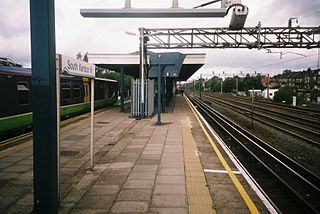
South Kenton is an interchange station in Kenton, north-west London. The station is served by suburban services on the Bakerloo line of the London Underground and the Lioness line of the London Overground. The station lies between Kenton and North Wembley stations. It is located between The Link in the Sudbury Court Estate of North Wembley, and Windermere Grove in Kenton, in the Wembley postal area.

Kenton is an interchange station situated on Kenton Road in Kenton, north-west London. It is served by the Bakerloo line of the London Underground and the Lioness line of the London Overground. It also has an out-of-station interchange with Northwick Park station on the London Underground's Metropolitan line.

Harrow & Wealdstone is an interchange station located in Harrow and Wealdstone in the London Borough of Harrow. It is situated on the Bakerloo line of the London Underground, of which it is the northern terminus; the Lioness line of the London Overground; and on the West Coast main line (WCML) for National Rail services operated by London Northwestern Railway and Southern.

Watford Junction is a railway station serving the town of Watford in Hertfordshire, England. The station is on the West Coast Main Line (WCML), 17 miles 34 chains (28 km) from London Euston and the Abbey Line, a branch line to St Albans. It is also the northern terminus of the Lioness line of the London Overground, which operates via the Watford DC line into central London.
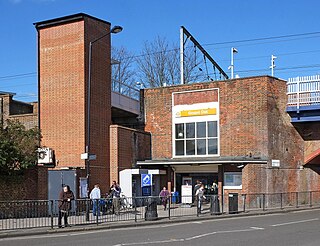
Gospel Oak is a London Overground interchange station in the London Borough of Camden in north-west London. It is the western terminus of the Suffragette line to and from Barking Riverside, and is also situated on the Mildmay line between Clapham Junction/Richmond and Stratford. Passengers using Oyster cards are required to tap on interchange Oyster card readers when changing between the two lines. The station is in Travelcard Zone 2.

Kensington (Olympia) is an interchange station between the Mildmay line of the London Overground and National Rail services operated by Southern, located in Kensington, West London. Limited services on the District line of the London Underground also operate to here.

The West London line (WLL) is a short railway in inner West London that links Willesden Junction in the north to Clapham Junction in the south. The line has always been an important cross-London link, especially for freight services. Southern and London Overground provide regular passenger services; detailed below.
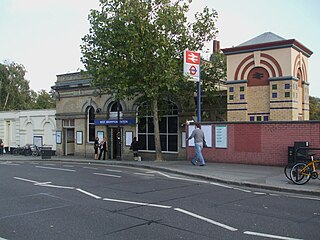
West Brompton is a Grade II-listed interchange station located on Old Brompton Road (A3218) in West Brompton, West London. The station is served by the District line of the London Underground; the Mildmay line of the London Overground; and National Rail services operated by Southern along the West London line.

Kilburn High Road is a London Overground station on the Lioness line, situated near the south end of the Kilburn High Road in the London Borough of Camden.

Hatch End is a London Overground station on the Lioness line, situated in the London Borough of Harrow in north London. It is located in Travelcard Zone 6. The station was formerly served by the Bakerloo line of the London Underground from 16 April 1917 until 24 September 1982.

Bushey is an interchange station in Hertfordshire which serves Bushey and Oxhey. It is located on an embankment where the Watford DC line, operated as the Lioness line of the London Overground, diverges from the West Coast Main Line (WCML). National Rail services along the WCML are operated by London Northwestern Railway.

The Watford DC line is a suburban railway line from London Euston to Watford Junction in Greater London and Hertfordshire. Its services are operated by London Overground for the whole length of the line and the Bakerloo line of the London Underground between Harrow & Wealdstone and Queen's Park.




